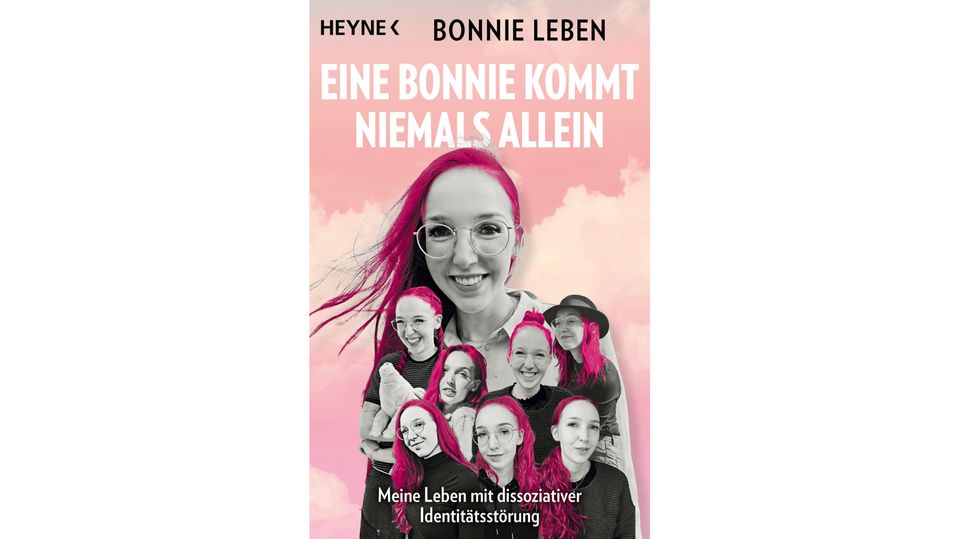Many identities share one body. What sounds like science fiction is reality for some people, including the Bonnies. They suffer from “dissociative identity disorder”. Four of them told us their stories.
recorded by Leonie Zimmermann
Who doesn’t know them, the inner voices that like to speak up, especially before important decisions – and represent completely opposing views. We all have different personality traits that don’t always pull together. But what if the whole thing isn’t just happening in our heads, but is so pronounced that we consist of several distinct personalities? Then we speak of a “dissociative personality disorder”. Identity disorder“. But what is it like to be many?
The Bonnies know this very well, they have “dissociative identity disorder” and speak up Social media about how this shapes their lives. They don’t know how many Bonnies there are – a new character always appears. But the whole thing only really becomes tangible when you get to know a few of them, when you hear them speak and see that really different characters live in one person. Four of the Bonnies took us exclusively into their world of thoughts. We’ll learn in the next few days TessaIsa, Fiona and 46 know something better. This time it’s Isa’s turn.
I’m Isa and I’m 20 years old. That means that in the last few years I was always a little bit younger than my 24-year-old body, and then I aged along with it. Most of the time I don’t really know how I feel, I don’t have the feeling for it. That’s because I’m only ever there very selectively and can’t remember the time when I’m not there. I think I’m doing pretty well though. Although I have always carried a lot of sadness within me, from all of us. As a result, I often cry, but I can also have very intense positive feelings, which has something healing for all of us.
What is Dissociative Identity Disorder?
In “Dissociative Identity Disorder” multiple identities exist in one person. They can differ significantly in behavior, way of thinking and language and sometimes do not remember each other’s experiences. The condition used to be known as multiple personality. Roughly speaking, dissociation means a split in our thoughts, actions or feelings.
The extreme form of dissociation is considered a trauma-related disorder. This means that it arises from traumatic experiences in early childhood. If small children experience persistent sexual, physical or psychological violence, it can happen that they are unable to fully develop their personality and instead split it into different parts in order to be able to process the whole thing better.
Psychiatrists make the diagnosis based on a detailed anamnesis and special questionnaires. The condition is extremely rare; it is estimated that around 0.5 percent of people suffer from it. The diagnosis can be found in the ICD and is therefore considered an official diagnosis, although some experts see it as controversial. Others suspect that the number of unreported cases could be much higher, as many psychiatrists do not take those affected seriously. Once the diagnosis has been made, psychotherapy can help to integrate the personality traits or at least establish cooperation between them.
For me, being many is not at all tangible, it never was. I have always been solely responsible for everyday life. At school I was actually mostly in my body, and for a long time in my youth in my free time too. I thought the life I led back then was everything. I didn’t realise that there were also times that I didn’t experience. But I found some crazy explanations for these gaps in time and convinced myself, for example, that I was sleeping or that I was just super forgetful. Ultimately, however, these were always the only signs of being many for me.
Injuries out of nowhere – right?
Well, apart from the hospital stay about two years before the diagnosis. Back then, we were torn from our seemingly dream life overnight. A life in which, just a few days before, I had happily celebrated my graduation and led a life that many others envied me for. At least, that’s what I thought for a long time. In hospital, I was therefore unable to explain my serious injuries; neither the doctor nor I could figure out the cause. At the time, I said I had injured myself. I knew it was a lie – but I had no memory of what had happened to me. All of this made me incredibly sad, without knowing any tangible reason for my tears. But deep down, I seemed to already know that my life was not perfect.
It took another two years until we were diagnosed with “dissociative identity disorder” in a trauma clinic at the age of 18. Until then, it was mostly everyday people like me outside. Being outside means that you control the actions of your body, so you are the main person in the moment. We all had no idea what bad things had happened to us. I initially denied the diagnosis because I couldn’t imagine that there was so much inside me that I didn’t know anything about and that I didn’t have access to. For a long time I asked myself whether my life would not have been much easier in the uncertainty of being many, whether I would be so happy.
I’m getting better at dealing with it now because it obviously explains a lot – not just the gaps in time, but also the pain, the physical limitations and the different handwriting in my diary. I still can’t grasp it properly – and I still have no access to the inner world. That means if I’m not in the body, then I’m just gone. It’s not even like I’m sleeping. I don’t notice this time at all. Sometimes that takes a toll on me because I’m a very emotional person and find time in my life so precious. I’ve had so many great experiences and actually like my life. But I know I don’t have it to myself. And if I’m not there, I don’t know when I’ll come back next time. I might be talking to you and having the time of my life and the next minute someone will replace me and I won’t be back for another two weeks. Or in two years. And these two years are a lost lifetime for me.
And to be honest, it also scares me that I don’t know what else is inside me that I don’t have access to. Getting the diagnosis and learning that I had been experiencing trauma for years and hadn’t noticed it, despite having injuries all over my body, was a shock. You have to understand that at the time when I was first told this, the traumatizing actions were still taking place. And I just didn’t get it. Instead, I maintained my illusion for as long as I could. That’s why I sometimes wonder what else will come up over time that I don’t know about yet. Which memory of other people will knock me off my feet next? It unsettles me and sometimes drives me crazy. But I’ve accepted it as my life now.
Anxious, avoidant or secure: couples therapist explains how which attachment style develops
04:47 min
The difficulty of dealing with trauma
I think many of us still think that we don’t have enough time in life to process all of our traumas. This means we have to set priorities – and that is sometimes hard. But maybe that’s not the point at all. Perhaps it is rather our job to build a life that creates a positive counterbalance and makes our past bearable. For example, I prefer to spend my time in nature. I’m outside a lot and try to soak up this life as often as possible. That is my greatest need.
But I’m not alone. That’s why I hope in the future that the needs of people who haven’t been in the body that often will also be met. Unfortunately, that’s just the way it is: When there are a lot of people, someone always falls by the wayside; you can never please everyone. Nevertheless, I hope that we continue to try to find a good balance. Fortunately, we have already partially achieved that; we are on the right track.

All the symptoms and memories have become more bearable as a result. The certainty that, looking back (on the outside), we were never alone with this gives me courage. We often felt lonely and overwhelmed, but we were never really alone. I think our first therapist saved our lives in that respect. Simply because she was there and helped me to understand what was going on inside me. And that is much more than you can imagine.
This protocol is the second part of a four-part series on the topic of “Dissociative Personality Disorder.” We think: In order to even begin to understand what it feels like to be “many”, you should listen to more than just one of the personality parts. That’s why we let four of the Bonnies have their say – and take us into their world. In the next part we get to know Tessa. She’s only ten years old – and doesn’t really understand all the adult stuff yet.
This is part two of the series.
Part one of the series can be found .
Part three of the series can be found here.
You can find part four of the series here.
Source: Stern
I’m Caroline, a journalist and author for 24 Hours Worlds. I specialize in health-related news and stories, bringing real-world impact to readers across the globe. With my experience in journalism and writing in both print and online formats, I strive to provide reliable information that resonates with audiences from all walks of life.




